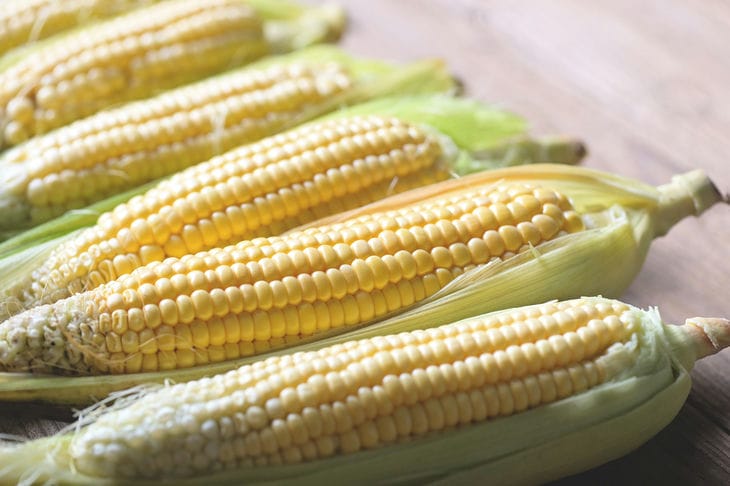Many people love corn for its delicate and pleasant taste and aroma, its incomparable attractive appearance. Its taste is not like any other product.
It depends on the variety. And the beneficial properties of boiled corn are simply enormous for the body.
People often wonder what health benefits and harms corn brings in boiled and canned form, because it is a favorite product of most people.
It is said that this grain has been eaten all over the world for over 12,000 years. But long ago, the size of the cob was only 4 centimeters. Corn, which we are so familiar with today, came to Russia already in the 17th century and has been actively grown as a cereal grass crop since then.
It is not considered a vegetable, as many people think, and the great advantage of this plant is that even if fertilizers and chemicals were used during its cultivation, they are not deposited in the cobs. That is why this product, like buckwheat, is called environmentally friendly.

What vitamins are in corn
This wonderful cereal contains a lot of various vitamins and microelements that are necessary for the functioning of the human body, and since they are organic, they are perfectly absorbed by it, improving both the condition of the internal organs and the external physical appearance.
If you really love this wonderful product, you will be interested and useful to know what vitamins remain in boiled corn after heat treatment. These are vitamin A (0.3 mg), B1 (0.4 mg), B2 (0.1 mg), B3 (0.7 mg), B4 (71 mg), B6 (0.5 mg), B9 (46 mcg), C (7 mg), E (5.5 mg), H (21 mcg), PP (2.1 mg), as well as the following microelements: magnesium (73 mg), iron (0.5 mg), potassium (270 mg), phosphorus (301 mg), titanium (28 µg), nickel (84 µg), copper (290 µg), tin (29 µg), sulfur (114 µg), zinc (1730 µg), chlorine (54 mg), iodine (5.2 µg), vanadium (93 µg), aluminum (440 µg), boron (270 µg), calcium (46 mg).
This is a very good dietary cereal, in boiled corn there are only 86 kcal per 100 grams. Even the tribes of Ancient Mexico widely used corn in everyday life, and therefore it is considered the most ancient of cereals and the only one in the genus "corn".
The beneficial properties of boiled corn should not be underestimated, because this product has a beneficial effect on the nervous system, helps with gout, neuralgia, liver diseases, epilepsy, nephritis. As scientists have recently discovered, the grain contains pectin - a substance that can fight tumors.
Athletes, children, pregnant women are recommended to eat boiled corn, raw corn, corn porridge and flakes more often. After all, this is an irreplaceable product that is perfectly absorbed by the body and is suitable for absolutely everyone.
How to choose tasty corn
Prefer the Dutch variety, because it not only cooks quickly, but is also the sweetest of all currently existing in the world. The grains remain juicy and soft after cooking and burst right in the mouth. This corn will be the most delicious.
When choosing cobs, pay attention to their arrangement: the grains should fit tightly to each other, be dense and swollen, should be easily pierced with a fingernail and release juice. The color of the grains can be creamy yellow, but not yellow-orange (old overripe cobs). Make sure there is no rot or black plaque.
Also check for worms, because the cob can be pretty much eaten by them. But, of course, this is a good sign, because worms will not eat harmful products. If there is a little worminess only on the top, but the corn itself is excellent, take it boldly, just cut off the eaten part with a knife.
How long to cook fresh corn
When buying fresh corn, check what kind you got. The cooking time directly depends on this. For example, Dutch varieties need 30-45 minutes to cook until fully cooked, and some others - 1.5 hours.
Adding salt or sugar to the cooking water will not improve the taste of the cobs, so it is better to ask the name of the varieties and remember which one you like best. We recommend choosing, again, Dutch corn. Store purchased corn in the refrigerator for no more than 3 days, after which its beneficial properties are noticeably reduced.
If you are interested in how to cook fresh corn, clean the cob from leaves and panicles, cut off the leg and put as much as will fit on the bottom of the pan, in layers. Leave at least 7-10 cm of free space at the top. Cover the corn with panicles, and then with the youngest leaves, pouring water. Cover with a lid and time it after boiling for 45 minutes to 1.5 hours. Check the grains for readiness by piercing them with a fork (they should burst easily).
Benefits and harms of canned corn
Before buying canned corn, read the ingredients and check the expiration dates.
Choose a product with a shorter shelf life: 1-2 years, because it contains fewer preservatives.
This cereal has a number of contraindications:
- exacerbation of gastrointestinal ulcers;
- increased blood clotting;
- thrombophlebitis, thrombosis;
- low body weight.
In such cases, it is better to refuse the product completely or treat it with extreme caution.








